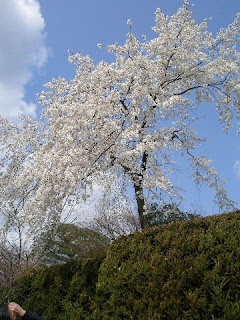
If you walk 5 minutes from Nijo Castle in Kyoto, you'll find a small cafe called
'Ran Hotei' (sorry, but only in Japanese) in Sanjo Shopping Street. This machiya cafe (machiya=町屋 are traditional wooden townhouses found a lot in Kyoto) is a place where you can experience Japanese tea ceremony. (2,500yen per person & advance reservation required.)

The grand floor is a cafe space. So you may not believe you can learn about tea ceremony here. But when you go up to the first floor, you find table-style tea ceremony space.

A formal tea ceremony is held in a room with tatami mats, but these days even Japanese people find it difficult to sit on tatami floors for a long time.
Here, you can see tea ceremony and ask questions sitting on a chair.

But before start, we go downstairs and visit the small garden in the back.

This garden with wooden bench is a waiting place. We come & wait here till the ceremony starts, but it's also a place where we forget our daily life and get ready for the ceremony.
Here, our host, Mr. Randall Channell explains what tea ceremony is, and brief procedures of tea ceremony and so on.
I shall call him 'Randy sensei' from now on. 'Sensei=先生' means 'teacher' or 'instructor' in Japanese.
Randy sensei is Canadian, and he started his tea study in 1985 and and received his first teaching license in 1996. He often shows up in media including TV and is pretty famous now throughout Japan. For more details of his life, please check
his homepage.

After hearing his explanation and having Q&A Time, we go back upstairs. Then there waiting lovely sweets. Can you guess what the motif is? It's a Japanese medlar (枇杷)!! Sweets are definitely one of the most enjoyable things in tea ceremony (for me. ;P)

And now, he starts making tea. This tea making procedures is called 'otemae=お点前.' We see his otemae enjoying the sweets. If we have any questions, we are free to ask.

Even in Kyoto, there are a few places we can experience tea ceremony in English. Randy sensei is a native English speaker & an associate professor of Urasenke school. To solve your questions about tea ceremony, this is a right place to come.

Woops! Who is it?
Well, you can actually make a cup of tea by yourself @Ran Hotei.

After the tea ceremony, my friend and I stayed nearly an hour at cafe downstairs. (Yes, I must admit I have a piece of chocolate green tea cheese cake.) This cafe has both tatami space and table & chair space.


Although this building was totally renovated, you still find origina beams and walls. A Japanese old machiya & art deco decoration matched well.

And it's fun to see antiques. This is a stair-type drawer or stairs with drawer function?? I don't know what you call it in English. If you have any ideas, please let me know!!



























